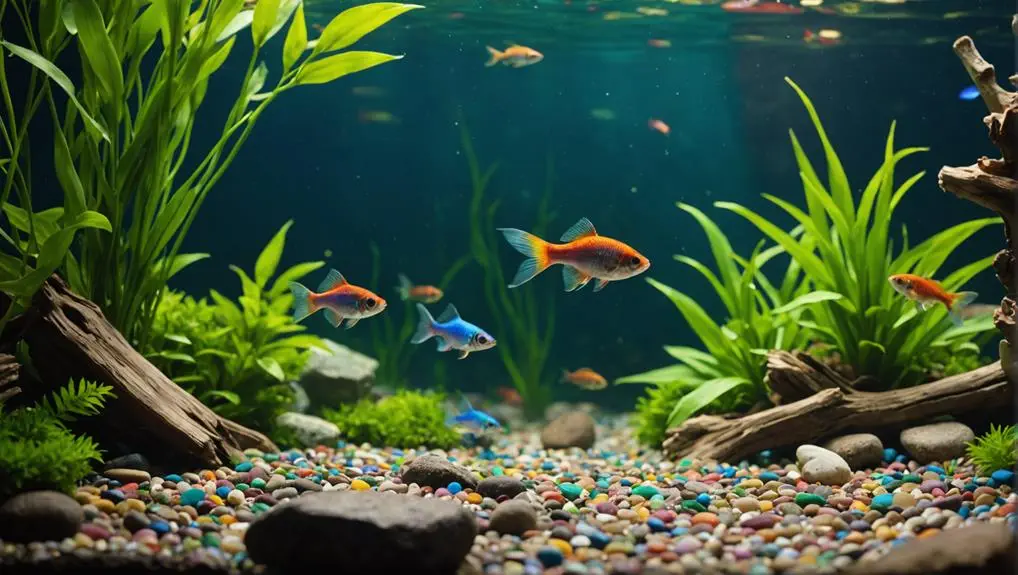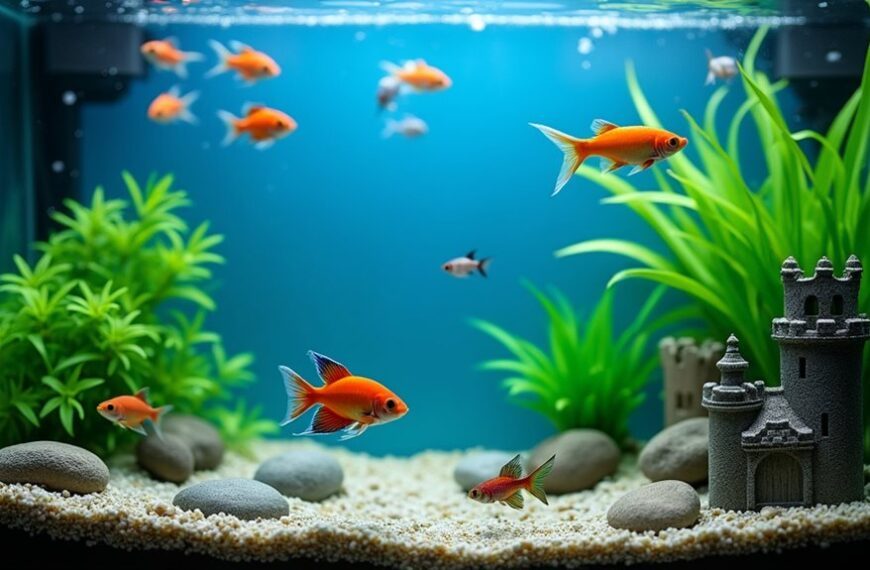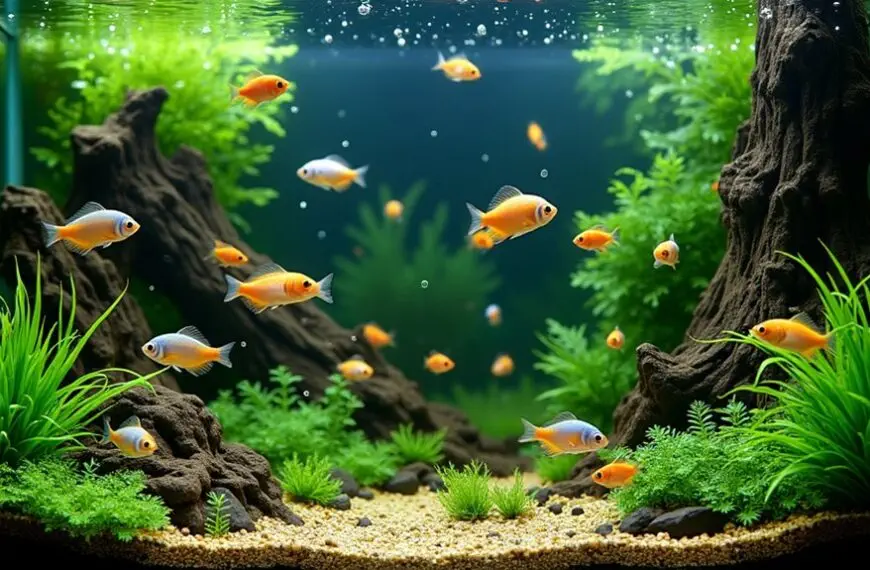When you're starting out in the aquarium world, choosing the right fish can make all the difference. Opt for hardy species like Guppies, Neon Tetras, Betta Fish, Platies, and Mollies. Guppies are super adaptable and can handle a range of water conditions. Neon Tetras love to school, so get at least six for a colorful show. Betta Fish prefer their own space, while Platies and Mollies add some cheerful vibrations to your tank. Remember, keeping the peace among your fish buddies is vital, so a little compatibility research goes a long way. Stick around, and you'll discover even more helpful tips!
Contents
Understanding Fish for Beginners
When starting your journey in fishkeeping, it's crucial to choose the right fish to set you up for success. You'll want to begin with beginner fish like guppies, neon tetras, and betta fish. These little guys are known for their resilience and adaptability, making them great beginner pets.
Ensuring high water quality is essential for the well-being of your fish, as good water quality minimizes stress, promoting happier fish and enhancing their growth, breeding, and longevity. If you're looking for peaceful community fish, consider livebearers like platies and mollies. They're easy to care for, and their lively nature can quickly make your tank feel bustling.
For a harmonious environment, choose schooling fish like corydoras and rasboras. These species thrive in groups of at least five, which helps keep the peace in your small freshwater tanks.
Remember, monitoring water parameters like pH and temperature is essential for keeping your fish happy. Guppies, for instance, prefer a cozy 68-78°F with a pH of 6.5-8.0.
Your first fish should be manageable, typically ranging from 1 to 4 inches in size. This makes them perfect for smaller tanks of 5 to 20 gallons. So, dive in and enjoy the rewarding experience of creating a thriving aquatic community!
Essential Tank Size Considerations
When you're picking out your new fish tank, size really does matter! A 10-gallon tank is a great starting point for small fish, giving them room to swim and keeping the water nice and stable.
Proper cycling of your tank is crucial to establish beneficial bacteria that will help maintain a healthy environment for your fish, as highlighted in the importance of monitoring water parameters.
Ideal Tank Dimensions
Choosing the right tank dimensions is crucial for the health and happiness of your fish.
Whether you're starting with small fish like Tetras and Guppies or considering a community tank with peaceful fish, the tank size matters. For beginners, a 5-10 gallon fish tank is ideal for small fish, allowing them to thrive comfortably.
If you're feeling adventurous, a 20-50 gallon tank opens up options for tropical fish like Barbs and Gouramis.
These sizes can accommodate fish up to 3-4 inches, making them perfect for a charming community setup. Just remember the stocking guidelines: too many fish in a small space can lead to stress and poor water quality.
As you get more experienced, larger tanks—55 gallons and up—become necessary for bigger fish like Cichlids and Oscars.
They need space to swim and establish territories. This larger size is vital for keeping the water clean and stable, especially with their higher bioloads.
Species Size Compatibility
Understanding species size compatibility is vital for maintaining a harmonious aquarium. When you're selecting fish for beginners, consider their adult sizes. For small aquariums—like those between 5 to 10 gallons—opt for easy-to-keep species such as guppies, neon tetras, and rasboras. These little guys only reach about 1 to 3 inches, making them perfect for cozy spaces.
However, if you're dreaming of a peaceful community tank, be cautious with larger fish. Goldfish, for example, need a whopping 30 gallons each because they can grow up to 14 inches.
Mid-sized tanks, ranging from 20 to 50 gallons, are ideal for fish like platies and barbs, who often grow 3 to 4 inches and thrive in schools.
Don't forget about cichlids like angelfish! They require at least a 55-gallon tank, given their size and territorial nature.
A balanced mix of top, middle, and bottom dwellers in your aquarium will help ensure that your fish are compatible tank mates. By keeping an eye on water parameters and sizes, you'll create a lively home for your active swimmers. Happy fish keeping!
Ideal Fish Species Overview
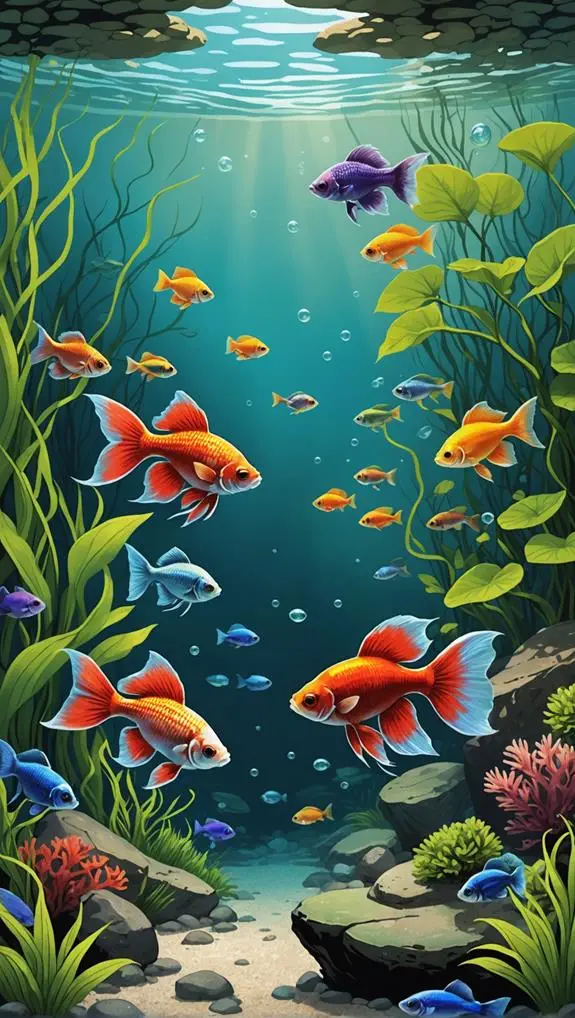
When you're starting your fish-keeping journey, picking the right species is key to your success and enjoyment. You'll want to consider factors like tank size, care requirements, and how well your new fish will get along with others.
Establishing a stable environment with appropriate essential setup and equipment is crucial for your fish's well-being. Whether you're eyeing a vibrant Betta or a friendly Corydoras, understanding these points will help you create a thriving aquatic community that's both beautiful and harmonious!
Best Starter Species
For new aquarists, selecting the right fish species can make all the difference in creating a thriving aquarium. If you're looking for popular beginner fish, consider guppies.
These vibrant little swimmers are easy to care for and adapt well to different conditions. Just remember, it's best to start with a ratio of one male to two or three females to keep the peace.
Neon tetras are another fantastic choice. These peaceful fish thrive in groups of six or more, adding a splash of color to your community tank.
Plus, they're small enough to fit into most small aquariums.
If you want some bottom-dwellers, Corydoras catfish are gentle and helpful in keeping your tank clean.
They do well in groups of at least three and grow to about 2-3 inches, making them perfect for beginners.
Lastly, betta fish are stunning and easy to care for, but remember to give them their space—they prefer to swim solo.
With the right mix of these species, you'll create a joyful aquatic environment.
And if you ever need help, don't hesitate to reach out to aquatic veterinary services!
Community Tank Compatibility
Creating a harmonious community tank is essential for both the health of your fish and the enjoyment of your aquarium. When you think about stocking your tank, consider peaceful schooling fish like neon tetras and rasboras. They thrive best in groups of six or more, so think of them as the social butterflies of your aquatic world!
Don't forget about small, friendly bottom dwellers like corydoras catfish. They not only contribute to keeping your tank clean, but they also prefer to hang out in groups of three to six.
As a beginner, you might also enjoy adding colorful livebearers like platies and guppies, which are super compatible with other gentle fish.
However, be cautious and avoid mixing aggressive species, such as male bettas or tiger barbs, with the more docile fish. You want your community to be peaceful and harmonious!
Lastly, remember to consider your fish's size and the tank volume. Many community fish fit nicely in smaller setups, but keep an eye on those larger breeds, like goldfish, which need more space.
Happy fish-keeping!
Size and Care Requirements
Choosing the right fish for your aquarium involves understanding their size and care requirements, which can greatly influence the success of your aquatic environment.
For smaller tanks, like the 5-10 gallon ones, consider adding Neon Tetras or Guppies. They grow to only 1-2 inches and thrive in small groups, making them perfect for peaceful community setups.
If you have a 20-50 gallon tank, Platies and Barbs, which reach about 3-4 inches, are fantastic choices. They get along well in community tanks and enjoy plenty of swimming space.
For larger tanks, say 55-120 gallons, Bolivian Rams and Angelfish can be excellent options, growing to about 3-6 inches but needing specific water conditions.
Don't forget about bottom dwellers like Corydoras catfish! They do well in tanks of 20 gallons and up and should be kept in groups of at least three.
Livebearers like Mollies and Swordtails are also hardy beginner fish that can reach 3-4 inches.
Community Tank Compatibility
When setting up a community tank, it's crucial to select fish that not only share similar sizes and temperaments but also thrive in the same environmental conditions.
Peaceful nano fish like tetras, rasboras, and corydoras make excellent choices due to their schooling nature. These fish not only get along well but also create a vibrant atmosphere in your aquarium, making it a joy to watch.
When introducing new fish, take your time and monitor established tank residents. This helps minimize any aggressive behavior and ensures community tank compatibility. Avoid aggressive fish, like male bettas or barbs, as they might harass smaller, more docile species, leading to unnecessary stress.
To keep things harmonious, aim for a balanced mix of top, middle, and bottom-dwelling fish. This reduces competition for resources and contributes to a healthy environment.
Regular observation is key; watch how your fish interact and be prepared to step in if you notice any signs of stress or aggression.
Feeding and Care Practices
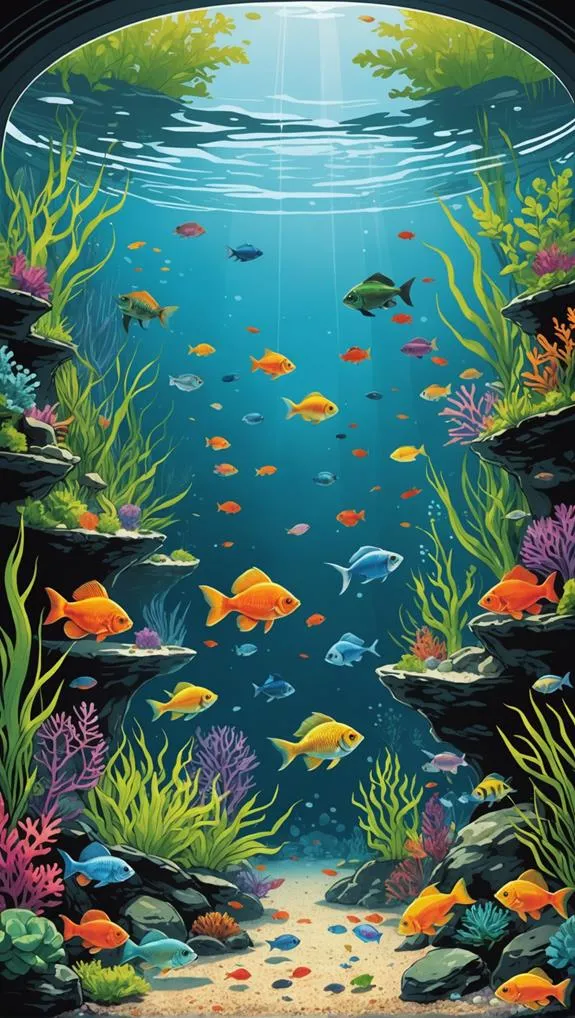
Feeding your fish properly is vital to their health and happiness. To keep your aquarium fish thriving, provide a varied diet that includes high-quality pellets, flakes, and occasional live or frozen foods. This not only meets their nutritional needs but also stimulates their natural hunting behaviors.
Remember, portion sizes matter! Overfeeding can lead to water quality issues and unhappy fish. A good rule of thumb is to feed only what they can consume in about 2-3 minutes.
If you have bottom-dwelling species like Corydoras or Kuhli Loaches, don't forget to include sinking pellets or wafers. These tasty treats ensure they get enough nutrition without competing with their tank mates.
Regularly checking water parameters and performing routine water changes is essential, too—keeping water quality stable is key to a happy fish family.
Lastly, each species has its own dietary preferences. Researching specific needs, like herbivore pellets for plant-eating fish, can help them grow strong and vibrant.
Behavior and Social Dynamics
In a thriving aquarium, understanding the behavior and social dynamics of your fish is essential for creating a harmonious environment.
You'll want to pay attention to schooling behavior, as many small freshwater fish, like tetras and rasboras, thrive in groups of at least six. This helps reduce stress and gives them a sense of security.
Now, let's talk about aggression and territoriality. Species such as tiger barbs can be a bit feisty, often defending their space or picking on less dominant tank mates.
So, choosing tank mates wisely is crucial to avoid any fishy drama!
On the flip side, peaceful species like cherry barbs and corydoras enjoy social interactions, enhancing their well-being.
If you're looking to breed, keep an eye on breeding behaviors; for example, male neon tetras tend to flaunt their bright colors during courtship.
Lastly, tank mate compatibility is key! While cherry barbs can peacefully coexist in community tanks, species like angelfish may be a tad more dominant.
Common Mistakes to Avoid
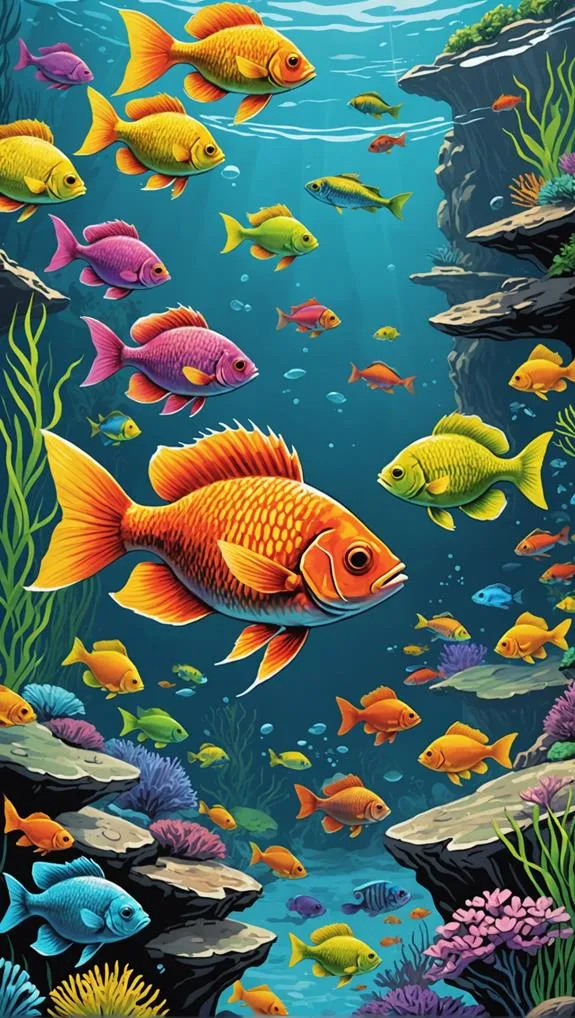
Creating a harmonious environment for your fish means avoiding some common pitfalls that new aquarists often encounter.
One major mistake is overcrowding tanks. Remember, following the fish-to-gallon ratio is crucial for ensuring your fish have enough space to thrive and reducing stress.
Another frequent oversight is neglecting to cycle your tank. This process establishes beneficial bacteria that break down harmful ammonia and nitrites, which are vital for fish health. Don't skip this step!
Also, take the time to research compatibility. A little homework can help you avoid aggressive interactions; not all fish play well together, after all.
Regularly monitoring water parameters like pH, ammonia, and nitrate levels is essential, too. Poor water quality can lead to disease, and nobody wants that for their aquatic friends.
Make it a habit to perform water changes to keep everything in check. Lastly, don't rely on tap water without a water conditioner. Harmful chemicals like chlorine can put your fish at risk.
Resources for New Aquarists
Finding reliable resources is essential for new aquarists looking to successfully navigate the world of fishkeeping. Start by visiting your local fish store. These places often have knowledgeable staff ready to help you with fish selection and care guidelines tailored to your new fish. They're like your friendly neighborhood fish gurus!
Online resources are another treasure trove. Fishkeeping forums and dedicated websites provide a wealth of shared experiences and troubleshooting advice from fellow aquarists.
You'll find care guides detailing everything from tank size to dietary needs, ensuring your fish thrive.
Don't forget about social media platforms! They host vibrant communities where you can ask questions and share your aquarium setups.
You might even discover local aquarium clubs that offer mentorship opportunities. Connecting with knowledgeable enthusiasts can enrich your learning experience while making new friends.
Frequently Asked Questions
What Is the Best Starter Fish for a New Aquarium?
When choosing your first fish, consider hardy species like guppies or neon tetras. Check compatibility charts, tank size, and water parameters to ensure successful community fish. Remember their feeding habits and maintenance requirements for a thriving aquarium.
What Is the First Fish to Put in a New Aquarium?
Starting an aquarium's like baking; you need the right ingredients. For your first fish, consider a guppy pair or zebra danios. They're hardy, tolerate varying conditions, and help establish your tank's ecosystem beautifully.
What Is the Best Fish to Add to a New Tank?
When adding fish to a new tank, consider compatibility, water parameters, and feeding routines. Ensure proper tank decor and aquatic plants while monitoring fish behavior. Regular tank maintenance and understanding the nitrogen cycle help prevent diseases.
What Are the Best Fish to Cycle a New Aquarium?
When cycling a new aquarium, consider species like guppies or zebra danios. They help manage ammonia levels and support beneficial bacteria growth. Ensure substrate considerations, tank size, and filtration system suit your fish's needs for optimal compatibility.
Final Thoughts
So, think of your aquarium as a vibrant little kingdom. You're the ruler, and the fish are your loyal subjects. By choosing the right species, creating a cozy home, and understanding their needs, you'll build a thriving underwater realm. Remember, every ruler faces challenges, but learning from your mistakes only makes you a wiser leader. Dive in, have fun, and enjoy the colorful tapestry of life that unfolds in your tank. Your fishy friends are waiting for you!

